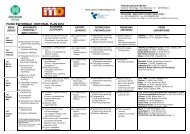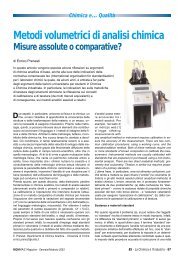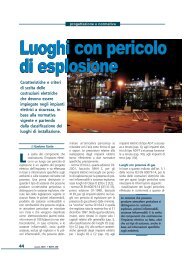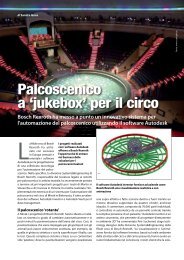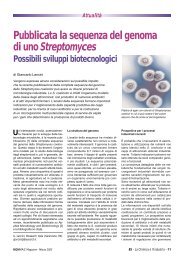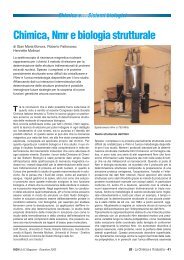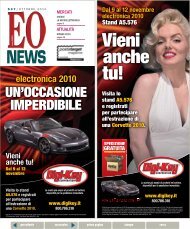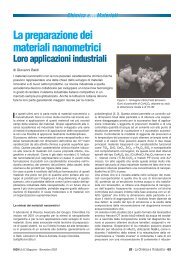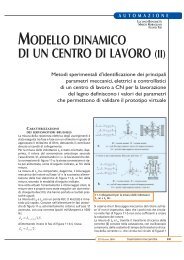NEWS - ilB2B.it
NEWS - ilB2B.it
NEWS - ilB2B.it
Create successful ePaper yourself
Turn your PDF publications into a flip-book with our unique Google optimized e-Paper software.
more in combination w<strong>it</strong>h other technologies. It must be able<br />
to be interfaced w<strong>it</strong>h the electronics found in all system departments,<br />
as well as speak the same ‘language’ and implement integrated<br />
functions. Nowadays, pneumatic components are<br />
made out of top qual<strong>it</strong>y materials and are a source of innovation<br />
for the world of miniaturisation. They also have the abil<strong>it</strong>y<br />
to be self-diagnostic. Furthermore, constant developments<br />
must be made to their level of flexibil<strong>it</strong>y, much higher than<br />
other technologies, when <strong>it</strong> comes to proposing components<br />
that have been designed to specific customer-requirements”.<br />
Daniele Marconi, the Sales Manager at Metal Work said: “I<br />
feel that <strong>it</strong> is only right to talk about the current s<strong>it</strong>uation on<br />
the industrial automation market, where the integration between<br />
pneumatics and electronics is a real<strong>it</strong>y that is being consolidated<br />
more and more. From the trad<strong>it</strong>ional component, we<br />
have moved on to an evolved product, one that is capable of<br />
conversing w<strong>it</strong>h data transmission protocols. Before long the<br />
so-called automation systems will be upon us which are capable<br />
of offering machine manufacturers everything they need to<br />
make their own equipment. Smaller geometries and performance<br />
levels that are increasingly higher and more customised<br />
will be indispensable characteristics for future components”.<br />
In many ways, pneumatics can be described as a rather mature<br />
form of technology. In automation circles, the main requests<br />
made by machinery manufacturers in the past regarded integration<br />
w<strong>it</strong>h the electronics and a reduction in both the weight<br />
and overall dimensions of components whilst maintaining the<br />
same performance levels. “Component miniaturisation - added<br />
Walter Severgnini, the Business Development Manager at<br />
SMC Italia - which for SMC has always been a must, has now<br />
become a standard of reference for almost all manufacturing<br />
companies, as is the integration of control electronics in packs<br />
of solenoid valves. Further developments in this field are also<br />
possible on the diagnostics front. Another development issue<br />
concerns the sensors that are used for mon<strong>it</strong>oring the functional<br />
pressure and flow parameters, moving on from analogical to<br />
dig<strong>it</strong>al gauging. Finally, present and future developments will<br />
include energy-saving, in terms of both the electrical absorption<br />
of solenoid valves and improved compressed air consumption<br />
levels”.<br />
The development of new components also involves the<br />
cost/performance ratio. “The constant and meticulous search<br />
for innovative and alternative materials - according to<br />
Emanuele Morandi, Pneumax’s Sales Manager for Italy - such<br />
as technopolymers, miniaturisation and ever-higher performance<br />
levels have made <strong>it</strong> possible to come up w<strong>it</strong>h sophisticated<br />
products where mechanics and electronics are being integrated<br />
more and more. Research & Development offices are constantly<br />
working towards overcoming the technological barriers, but<br />
the real question is: is today’s market, which, generally speaking,<br />
is more attentive over the cost rather than technology, willing<br />
to use avant-garde products that cost more?”.<br />
Signs of a recovery<br />
Figures on the pneumatics market in 2010 were pos<strong>it</strong>ive.<br />
Things started to pick up. Let’s try to find out what the trend<br />
will be for the next few months of this year. “Throughout 2010<br />
- remarked Mr. Severgnini - we w<strong>it</strong>nessed a vigorous recovery,<br />
backed by the fact that the sectors that were the most penalised<br />
over the last two years started to bounce back plus there was an<br />
increase in demand from foreign countries for machinery, said<br />
increase, however, was not big enough to bring levels back to<br />
those registered before the crisis”.<br />
Even though the economical outlook is still showing a great<br />
deal of uncertainty <strong>it</strong> is expected, as well as hoped for, that this<br />
trend will become consolidated and that, in 2011, we will get<br />
back to 2007 sales figures. “The domestic market is on the upturn<br />
- sustained Mr. Crepaldi -, many industrial sectors have<br />
reached 2008 figures, but the s<strong>it</strong>uation still needs evaluating<br />
very carefully. Italian manufacturers, which rely more on exports<br />
than on domestic demand, are looking for solutions that<br />
have the best price/performance ratio, a ratio penalised, above<br />
all, by the Asian market.<br />
Work will be undertaken on an international level, so that<br />
Asian companies become more aware of standards and regulations<br />
that are sufficient to maintain reliable qual<strong>it</strong>y levels”.<br />
“I feel that the Italian market - commented Mr. Morandi -, also<br />
and, above all, in light of the ever more frequent delocalisation<br />
operations implemented by many machine manufacturers,<br />
will be more static and <strong>it</strong> will find <strong>it</strong> difficult to generate<br />
any major growth levels. Much more promising is the export<br />
sector where development possibil<strong>it</strong>ies are much greater and in<br />
a state of ferment”.<br />
Different opinions capable of mapping out an overall picture<br />
of the pneumatic components industry.<br />
Mr. Belpasso, for example, sustained that <strong>it</strong> is necessary to develop<br />
processes that tend to improve corporate response in<br />
terms of logistics and service. This is what emerged from market<br />
analysis carried out by Bosch Rexroth: “After having w<strong>it</strong>nessed<br />
a year, 2010, where demand went up considerably and<br />
the recovery led to a general increase in the number of orders<br />
that were placed, 2011 should be a year based on further<br />
growth, albe<strong>it</strong> to a lesser extent, especially as far as the Italian<br />
market is concerned, whereas exports will continue to improve”.<br />
In 2010 the market value regarding pneumatic components in<br />
Italy was somewhere around the 530 million euros. The worldwide<br />
market, however, was worth approx. 7.4 billion Euros.<br />
“In 2011 - Mr. Kohler went on - further improvements on the<br />
market are expected: equal to 15% in Italy, w<strong>it</strong>h variations<br />
abroad, from area to area, ranging from 10% in Germany to<br />
25% in China. If the trend continues like this, after the slump<br />
in 2009, we could slowly but surely start heading back towards<br />
the record levels achieved in 2007 and 2008”.<br />
Over the last few years turnover from abroad has gone up more<br />
than that on the domestic market and <strong>it</strong> now accounts for 70%<br />
of Camozzi’s overall turnover. “The markets that are registering<br />
the highest growth levels are Russia, China, Brazil and India”,<br />
Mr. Kohler added.<br />
“I believe that, in 2011, the market value will be back to precrisis<br />
levels - Mr. Marconi pointed out -. There are no doubts<br />
that most companies will take advantage of the developments<br />
that are underway in the Bric area, Brazil, Russia, India and<br />
China, so increasing their export levels. Growth on domestic<br />
market, however, is more contained, w<strong>it</strong>h the emphasis more<br />
on recovery than on development”.<br />
Marco Belpasso,<br />
The Pneumatics Product Manager at Bosch<br />
Rexroth Italia, has always worked in<br />
automation, engineering and industrial<br />
development circles. He joined the company eight<br />
years ago as a pneumatics designer before<br />
becoming an applications engineer and he is now<br />
Product Manager; what’s more, he is responsible<br />
for the indirect issue of safety applied to the<br />
pneumatics industry.<br />
Rolf Kohler,<br />
the Strategic Marketing Manager at Camozzi,<br />
has more than twenty years of experience w<strong>it</strong>hin<br />
the automation industry, ten years dedicated to<br />
researching and developing products and<br />
components for a multinational company and<br />
ten years in various managerial pos<strong>it</strong>ions in sales<br />
and marketing for two multinationals. He has<br />
been the Strategic Marketing Manager at<br />
Camozzi for four years now.<br />
Giorgio Crepaldi,<br />
Marketing Manager at Festo spa since 2008.<br />
He joined the company in 1997 as a sales<br />
technician before becoming the Product<br />
Manager in 2003. He got a Master in<br />
Marketing Management at the SDA Bocconi<br />
Univers<strong>it</strong>y and then spent a year in Germany, at<br />
Festo’s headquarters in Esslingen, where he<br />
collaborated w<strong>it</strong>h the Product Management<br />
Drives section.<br />
Daniele Marconi,<br />
Sales Manager for the Metal Work Group and a<br />
Member of the Board of Directors. “I believe<br />
that, in 2011, the market value will be back to<br />
pre-crisis levels. There are no doubts that most<br />
companies will take advantage of the<br />
developments that are underway in the BRIC<br />
area, Brazil, Russia, India and China, so<br />
increasing their export levels”.<br />
Emanuele Morandi,<br />
Pneumax’s sales Manager for Italy. He has been<br />
working on the domestic and international<br />
pneumatics market for fifteen years; after<br />
working for six years in the Un<strong>it</strong>ed Kingdom,<br />
he then joined Pneumax in 2005, first as the<br />
Technical Support Manager, before taking up<br />
his current pos<strong>it</strong>ion in 2007.<br />
Walter Severgnini,<br />
Business Development Manager, has been<br />
working for SMC Italia since 1987. His<br />
experience lies in sales and marketing. “In<br />
2010, we w<strong>it</strong>nessed a vigorous recovery, backed<br />
by the fact that the sectors that were the most<br />
penalised over the last two years started to<br />
bounce back, plus there was an increase in<br />
demand from foreign countries for machinery”.<br />
PROGETTARE INTERNATIONAL<br />
9



